
|
plotjuggler repositorymqtt chart csv lua time-series plot qt5 ros px4 visualize-data rosbag ulog labstreaminglayer plotjuggler |
|
|
Repository Summary
| Description | The Time Series Visualization Tool that you deserve. |
| Checkout URI | https://github.com/facontidavide/PlotJuggler.git |
| VCS Type | git |
| VCS Version | main |
| Last Updated | 2025-05-25 |
| Dev Status | DEVELOPED |
| CI status | No Continuous Integration |
| Released | RELEASED |
| Tags | mqtt chart csv lua time-series plot qt5 ros px4 visualize-data rosbag ulog labstreaminglayer |
| Contributing |
Help Wanted (0)
Good First Issues (0) Pull Requests to Review (0) |
Packages
| Name | Version |
|---|---|
| plotjuggler | 3.10.5 |
README
Gold Sponsor: Greenzie
PlotJuggler 3.10
PlotJuggler is a tool to visualize time series that is fast, powerful and intuitive.
Noteworthy features:
- Simple Drag & Drop user interface.
- Load data from file.
- Connect to live streaming of data.
- Save the visualization layout and configurations to reuse them later.
- Fast OpenGL visualization.
- Can handle thousands of timeseries and millions of data points.
- Transform your data using a simple editor: derivative, moving average, integral, etc…
- PlotJuggler can be easily extended using plugins.
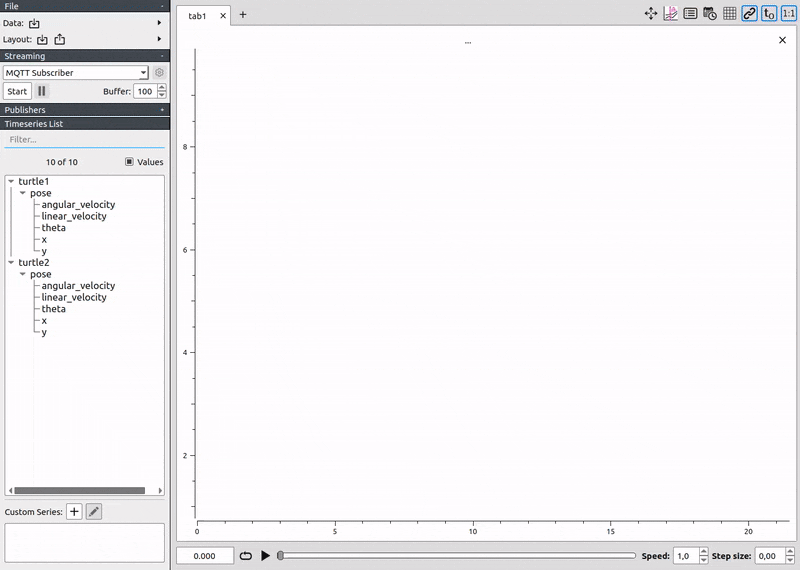
Data sources (file and streaming)
- Load CSV files.
- Load ULog (PX4).
- Subscribe to many different streaming sources: MQTT, WebSockets, ZeroMQ, UDP, etc.
- Understand data formats such as JSON, CBOR, BSON, Message Pack, etc.
- Well integrated with ROS: open rosbags and/or subscribe to ROS topics (both ROS1 and ROS2).
- Supports the Lab Streaming Layer, that is used by many devices.
- Easily add your custom data source and/or formats…
Transform and analyze your data
PlotJuggler makes it easy to visualize data but also to analyze it. You can manipulate your time series using a simple and extendable Transform Editor.
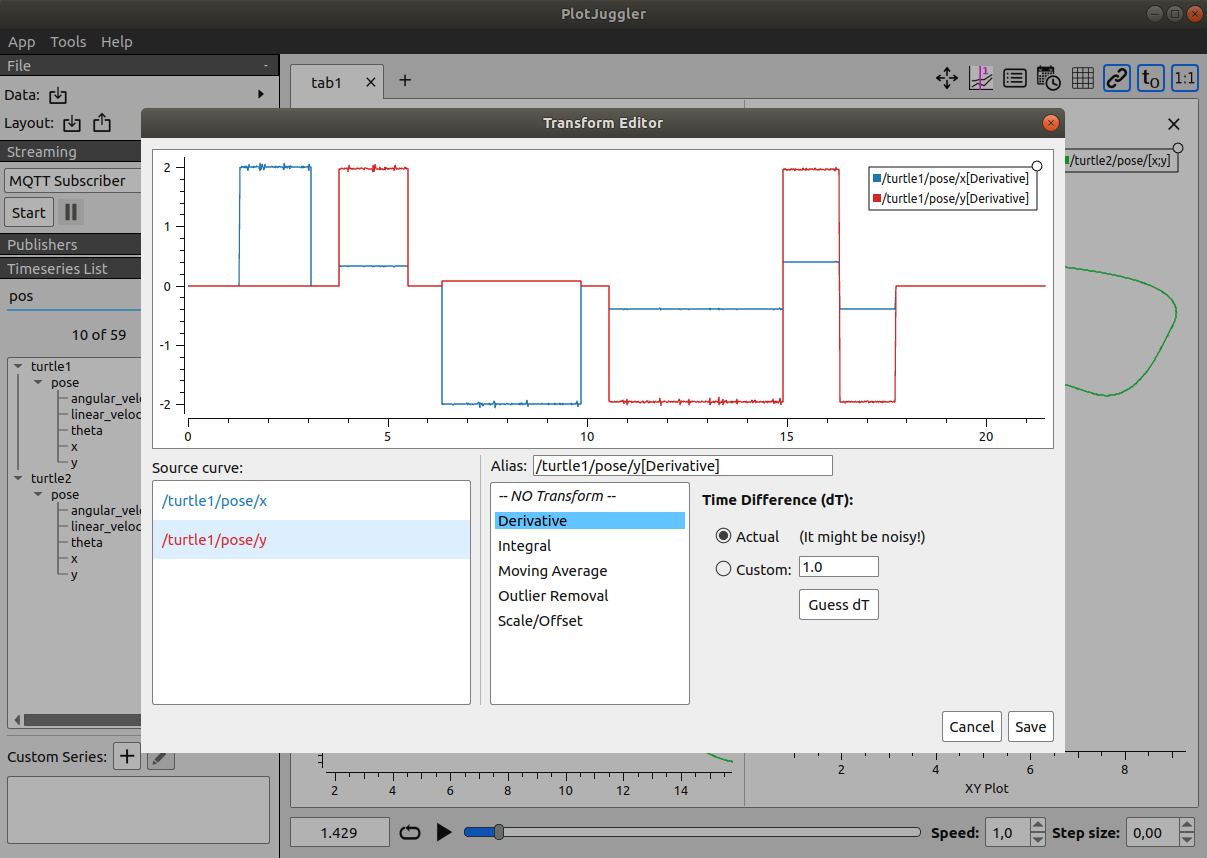
Alternatively, you may use the Custom Function Editor, which allows you to create Multi-input / Single-output functions using a scripting language based on Lua.
If you are not familiar with Lua, don’t be afraid, you won’t need more than 5 minutes to learn it ;)
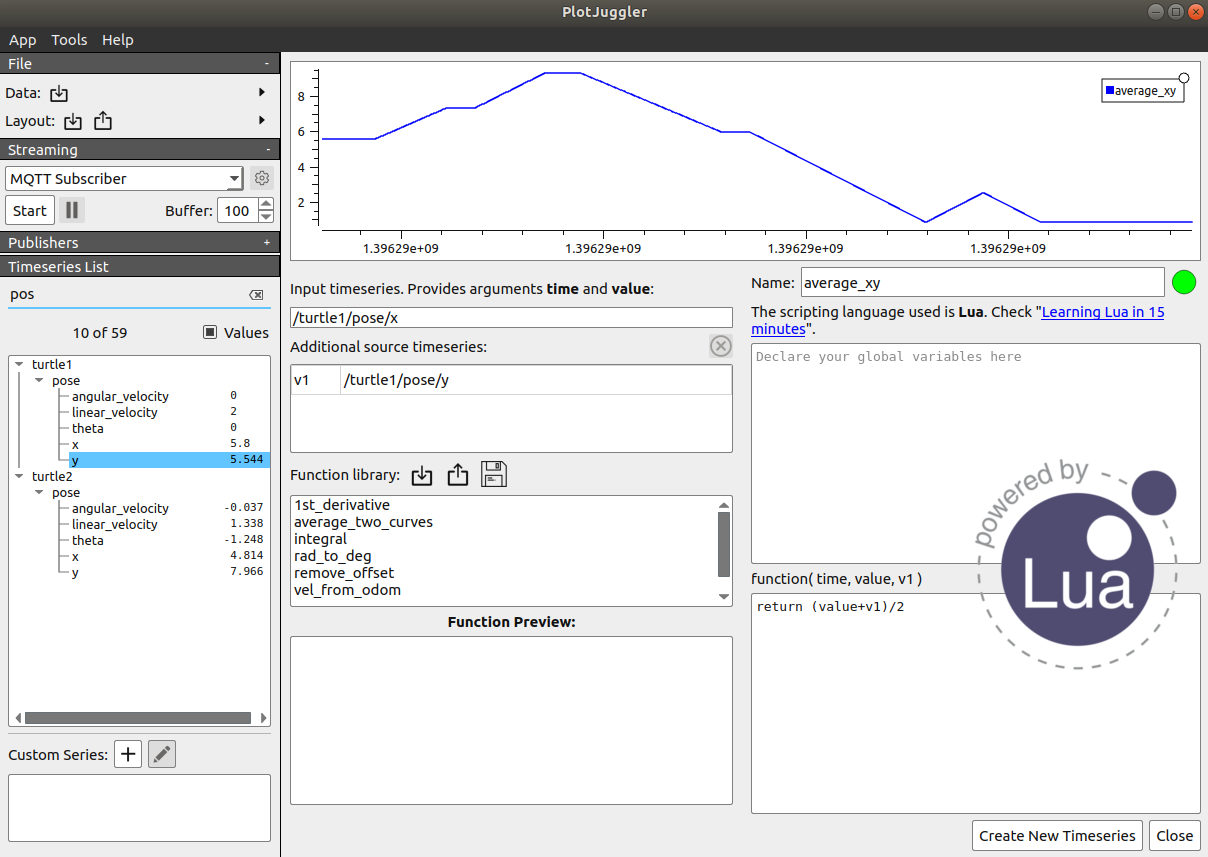
Tutorials
To learn how to use PlotJuggler, check the tutorials here:
| Tutorial 1 | Tutorial 2 | Tutorial 3 |
|---|---|---|
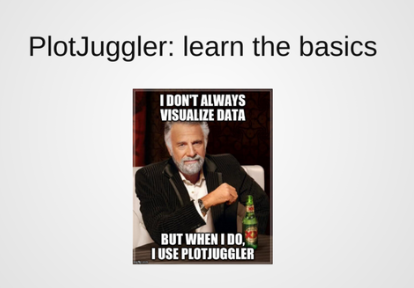 |
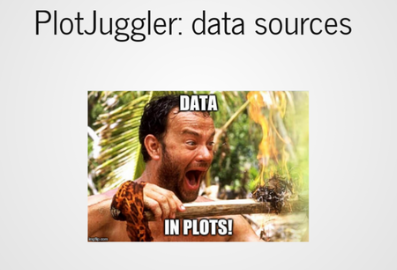 |
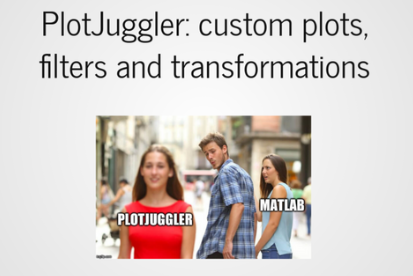 |
Supported plugins
Some plugins can be found in a different repository. The individual README files should include all the information needed to compile and use the plugin.
Please submit specific issues, Pull Requests and questions on the related Github repository:
If you want a simple example to learn how to write your own plugins, have a look at PlotJuggler/plotjuggler-sample-plugins
Installation
Snap (recommended in Ubuntu, to ROS users too)
The snap contains a version of PlotJuggler that can work with either ROS1 or ROS2.
To install it in Ubuntu 22.04, with ROS2 support, run:
sudo snap install plotjuggler
If you are still using ROS1 (Ubuntu 20.04), install instead:
sudo snap install plotjuggler-ros
Windows Binary installer
This installer does not include ROS plugins.
Windows Installer: PlotJuggler-Windows-3.9.3-installer
Debian packages for ROS User
Install the ROS packages with:
sudo apt install ros-$ROS_DISTRO-plotjuggler-ros
To launch PlotJuggler on ROS, use the command:
rosrun plotjuggler plotjuggler
or, if are using ROS2:
ros2 run plotjuggler plotjuggler
ROS plugins are available in a separate repository: https://github.com/PlotJuggler/plotjuggler-ros-plugins
Please take a look at the instructions in that repository if you want to compile PJ and its ROS plugins from source.
Compile from source
You can find the detailed instructions here: COMPILE.md.
Sponsorship and commercial support
PlotJuggler required a lot of work to develop and maintain; my goal is to build the most intuitive and powerful tool to visualize data and timeseries.
If you find PlotJuggler useful, consider donating PayPal or becoming a Github Sponsor.
If you need to extend any of the functionalities of PlotJuggler to cover a specific need or to parse your custom data formats, you can receive commercial support from the main author, Davide Faconti.
License
PlotJuggler is released under the Mozilla Public License Version 2.0, which allows users to develop closed-source plugins.
Please note that some third-party dependencies (including Qt) use the GNU Lesser General Public License.
Star History
Contributors
CONTRIBUTING

|
plotjuggler repositorymqtt chart csv lua time-series plot qt5 ros px4 visualize-data rosbag ulog labstreaminglayer plotjuggler |
|
|
Repository Summary
| Description | The Time Series Visualization Tool that you deserve. |
| Checkout URI | https://github.com/facontidavide/PlotJuggler.git |
| VCS Type | git |
| VCS Version | main |
| Last Updated | 2025-05-25 |
| Dev Status | DEVELOPED |
| CI status | No Continuous Integration |
| Released | RELEASED |
| Tags | mqtt chart csv lua time-series plot qt5 ros px4 visualize-data rosbag ulog labstreaminglayer |
| Contributing |
Help Wanted (0)
Good First Issues (0) Pull Requests to Review (0) |
Packages
| Name | Version |
|---|---|
| plotjuggler | 3.10.5 |
README
Gold Sponsor: Greenzie
PlotJuggler 3.10
PlotJuggler is a tool to visualize time series that is fast, powerful and intuitive.
Noteworthy features:
- Simple Drag & Drop user interface.
- Load data from file.
- Connect to live streaming of data.
- Save the visualization layout and configurations to reuse them later.
- Fast OpenGL visualization.
- Can handle thousands of timeseries and millions of data points.
- Transform your data using a simple editor: derivative, moving average, integral, etc…
- PlotJuggler can be easily extended using plugins.

Data sources (file and streaming)
- Load CSV files.
- Load ULog (PX4).
- Subscribe to many different streaming sources: MQTT, WebSockets, ZeroMQ, UDP, etc.
- Understand data formats such as JSON, CBOR, BSON, Message Pack, etc.
- Well integrated with ROS: open rosbags and/or subscribe to ROS topics (both ROS1 and ROS2).
- Supports the Lab Streaming Layer, that is used by many devices.
- Easily add your custom data source and/or formats…
Transform and analyze your data
PlotJuggler makes it easy to visualize data but also to analyze it. You can manipulate your time series using a simple and extendable Transform Editor.

Alternatively, you may use the Custom Function Editor, which allows you to create Multi-input / Single-output functions using a scripting language based on Lua.
If you are not familiar with Lua, don’t be afraid, you won’t need more than 5 minutes to learn it ;)

Tutorials
To learn how to use PlotJuggler, check the tutorials here:
| Tutorial 1 | Tutorial 2 | Tutorial 3 |
|---|---|---|
 |
 |
 |
Supported plugins
Some plugins can be found in a different repository. The individual README files should include all the information needed to compile and use the plugin.
Please submit specific issues, Pull Requests and questions on the related Github repository:
If you want a simple example to learn how to write your own plugins, have a look at PlotJuggler/plotjuggler-sample-plugins
Installation
Snap (recommended in Ubuntu, to ROS users too)
The snap contains a version of PlotJuggler that can work with either ROS1 or ROS2.
To install it in Ubuntu 22.04, with ROS2 support, run:
sudo snap install plotjuggler
If you are still using ROS1 (Ubuntu 20.04), install instead:
sudo snap install plotjuggler-ros
Windows Binary installer
This installer does not include ROS plugins.
Windows Installer: PlotJuggler-Windows-3.9.3-installer
Debian packages for ROS User
Install the ROS packages with:
sudo apt install ros-$ROS_DISTRO-plotjuggler-ros
To launch PlotJuggler on ROS, use the command:
rosrun plotjuggler plotjuggler
or, if are using ROS2:
ros2 run plotjuggler plotjuggler
ROS plugins are available in a separate repository: https://github.com/PlotJuggler/plotjuggler-ros-plugins
Please take a look at the instructions in that repository if you want to compile PJ and its ROS plugins from source.
Compile from source
You can find the detailed instructions here: COMPILE.md.
Sponsorship and commercial support
PlotJuggler required a lot of work to develop and maintain; my goal is to build the most intuitive and powerful tool to visualize data and timeseries.
If you find PlotJuggler useful, consider donating PayPal or becoming a Github Sponsor.
If you need to extend any of the functionalities of PlotJuggler to cover a specific need or to parse your custom data formats, you can receive commercial support from the main author, Davide Faconti.
License
PlotJuggler is released under the Mozilla Public License Version 2.0, which allows users to develop closed-source plugins.
Please note that some third-party dependencies (including Qt) use the GNU Lesser General Public License.
Star History
Contributors
CONTRIBUTING

|
plotjuggler repositorymqtt chart csv lua time-series plot qt5 ros px4 visualize-data rosbag ulog labstreaminglayer plotjuggler |
|
|
Repository Summary
| Description | The Time Series Visualization Tool that you deserve. |
| Checkout URI | https://github.com/facontidavide/PlotJuggler.git |
| VCS Type | git |
| VCS Version | main |
| Last Updated | 2025-05-25 |
| Dev Status | DEVELOPED |
| CI status | No Continuous Integration |
| Released | RELEASED |
| Tags | mqtt chart csv lua time-series plot qt5 ros px4 visualize-data rosbag ulog labstreaminglayer |
| Contributing |
Help Wanted (0)
Good First Issues (0) Pull Requests to Review (0) |
Packages
| Name | Version |
|---|---|
| plotjuggler | 3.10.5 |
README
Gold Sponsor: Greenzie
PlotJuggler 3.10
PlotJuggler is a tool to visualize time series that is fast, powerful and intuitive.
Noteworthy features:
- Simple Drag & Drop user interface.
- Load data from file.
- Connect to live streaming of data.
- Save the visualization layout and configurations to reuse them later.
- Fast OpenGL visualization.
- Can handle thousands of timeseries and millions of data points.
- Transform your data using a simple editor: derivative, moving average, integral, etc…
- PlotJuggler can be easily extended using plugins.

Data sources (file and streaming)
- Load CSV files.
- Load ULog (PX4).
- Subscribe to many different streaming sources: MQTT, WebSockets, ZeroMQ, UDP, etc.
- Understand data formats such as JSON, CBOR, BSON, Message Pack, etc.
- Well integrated with ROS: open rosbags and/or subscribe to ROS topics (both ROS1 and ROS2).
- Supports the Lab Streaming Layer, that is used by many devices.
- Easily add your custom data source and/or formats…
Transform and analyze your data
PlotJuggler makes it easy to visualize data but also to analyze it. You can manipulate your time series using a simple and extendable Transform Editor.

Alternatively, you may use the Custom Function Editor, which allows you to create Multi-input / Single-output functions using a scripting language based on Lua.
If you are not familiar with Lua, don’t be afraid, you won’t need more than 5 minutes to learn it ;)

Tutorials
To learn how to use PlotJuggler, check the tutorials here:
| Tutorial 1 | Tutorial 2 | Tutorial 3 |
|---|---|---|
 |
 |
 |
Supported plugins
Some plugins can be found in a different repository. The individual README files should include all the information needed to compile and use the plugin.
Please submit specific issues, Pull Requests and questions on the related Github repository:
If you want a simple example to learn how to write your own plugins, have a look at PlotJuggler/plotjuggler-sample-plugins
Installation
Snap (recommended in Ubuntu, to ROS users too)
The snap contains a version of PlotJuggler that can work with either ROS1 or ROS2.
To install it in Ubuntu 22.04, with ROS2 support, run:
sudo snap install plotjuggler
If you are still using ROS1 (Ubuntu 20.04), install instead:
sudo snap install plotjuggler-ros
Windows Binary installer
This installer does not include ROS plugins.
Windows Installer: PlotJuggler-Windows-3.9.3-installer
Debian packages for ROS User
Install the ROS packages with:
sudo apt install ros-$ROS_DISTRO-plotjuggler-ros
To launch PlotJuggler on ROS, use the command:
rosrun plotjuggler plotjuggler
or, if are using ROS2:
ros2 run plotjuggler plotjuggler
ROS plugins are available in a separate repository: https://github.com/PlotJuggler/plotjuggler-ros-plugins
Please take a look at the instructions in that repository if you want to compile PJ and its ROS plugins from source.
Compile from source
You can find the detailed instructions here: COMPILE.md.
Sponsorship and commercial support
PlotJuggler required a lot of work to develop and maintain; my goal is to build the most intuitive and powerful tool to visualize data and timeseries.
If you find PlotJuggler useful, consider donating PayPal or becoming a Github Sponsor.
If you need to extend any of the functionalities of PlotJuggler to cover a specific need or to parse your custom data formats, you can receive commercial support from the main author, Davide Faconti.
License
PlotJuggler is released under the Mozilla Public License Version 2.0, which allows users to develop closed-source plugins.
Please note that some third-party dependencies (including Qt) use the GNU Lesser General Public License.
Star History
Contributors
CONTRIBUTING

|
plotjuggler repositorymqtt chart csv lua time-series plot qt5 ros px4 visualize-data rosbag ulog labstreaminglayer plotjuggler |
|
|
Repository Summary
| Description | The Time Series Visualization Tool that you deserve. |
| Checkout URI | https://github.com/facontidavide/PlotJuggler.git |
| VCS Type | git |
| VCS Version | main |
| Last Updated | 2025-05-25 |
| Dev Status | DEVELOPED |
| CI status | No Continuous Integration |
| Released | RELEASED |
| Tags | mqtt chart csv lua time-series plot qt5 ros px4 visualize-data rosbag ulog labstreaminglayer |
| Contributing |
Help Wanted (0)
Good First Issues (0) Pull Requests to Review (0) |
Packages
| Name | Version |
|---|---|
| plotjuggler | 3.10.5 |
README
Gold Sponsor: Greenzie
PlotJuggler 3.10
PlotJuggler is a tool to visualize time series that is fast, powerful and intuitive.
Noteworthy features:
- Simple Drag & Drop user interface.
- Load data from file.
- Connect to live streaming of data.
- Save the visualization layout and configurations to reuse them later.
- Fast OpenGL visualization.
- Can handle thousands of timeseries and millions of data points.
- Transform your data using a simple editor: derivative, moving average, integral, etc…
- PlotJuggler can be easily extended using plugins.

Data sources (file and streaming)
- Load CSV files.
- Load ULog (PX4).
- Subscribe to many different streaming sources: MQTT, WebSockets, ZeroMQ, UDP, etc.
- Understand data formats such as JSON, CBOR, BSON, Message Pack, etc.
- Well integrated with ROS: open rosbags and/or subscribe to ROS topics (both ROS1 and ROS2).
- Supports the Lab Streaming Layer, that is used by many devices.
- Easily add your custom data source and/or formats…
Transform and analyze your data
PlotJuggler makes it easy to visualize data but also to analyze it. You can manipulate your time series using a simple and extendable Transform Editor.

Alternatively, you may use the Custom Function Editor, which allows you to create Multi-input / Single-output functions using a scripting language based on Lua.
If you are not familiar with Lua, don’t be afraid, you won’t need more than 5 minutes to learn it ;)

Tutorials
To learn how to use PlotJuggler, check the tutorials here:
| Tutorial 1 | Tutorial 2 | Tutorial 3 |
|---|---|---|
 |
 |
 |
Supported plugins
Some plugins can be found in a different repository. The individual README files should include all the information needed to compile and use the plugin.
Please submit specific issues, Pull Requests and questions on the related Github repository:
If you want a simple example to learn how to write your own plugins, have a look at PlotJuggler/plotjuggler-sample-plugins
Installation
Snap (recommended in Ubuntu, to ROS users too)
The snap contains a version of PlotJuggler that can work with either ROS1 or ROS2.
To install it in Ubuntu 22.04, with ROS2 support, run:
sudo snap install plotjuggler
If you are still using ROS1 (Ubuntu 20.04), install instead:
sudo snap install plotjuggler-ros
Windows Binary installer
This installer does not include ROS plugins.
Windows Installer: PlotJuggler-Windows-3.9.3-installer
Debian packages for ROS User
Install the ROS packages with:
sudo apt install ros-$ROS_DISTRO-plotjuggler-ros
To launch PlotJuggler on ROS, use the command:
rosrun plotjuggler plotjuggler
or, if are using ROS2:
ros2 run plotjuggler plotjuggler
ROS plugins are available in a separate repository: https://github.com/PlotJuggler/plotjuggler-ros-plugins
Please take a look at the instructions in that repository if you want to compile PJ and its ROS plugins from source.
Compile from source
You can find the detailed instructions here: COMPILE.md.
Sponsorship and commercial support
PlotJuggler required a lot of work to develop and maintain; my goal is to build the most intuitive and powerful tool to visualize data and timeseries.
If you find PlotJuggler useful, consider donating PayPal or becoming a Github Sponsor.
If you need to extend any of the functionalities of PlotJuggler to cover a specific need or to parse your custom data formats, you can receive commercial support from the main author, Davide Faconti.
License
PlotJuggler is released under the Mozilla Public License Version 2.0, which allows users to develop closed-source plugins.
Please note that some third-party dependencies (including Qt) use the GNU Lesser General Public License.
Star History
Contributors
CONTRIBUTING

|
plotjuggler repositorymqtt chart csv lua time-series plot qt5 ros px4 visualize-data rosbag ulog labstreaminglayer |
|
|

|
plotjuggler repositorymqtt chart csv lua time-series plot qt5 ros px4 visualize-data rosbag ulog labstreaminglayer plotjuggler |
|
|
Repository Summary
| Description | The Time Series Visualization Tool that you deserve. |
| Checkout URI | https://github.com/facontidavide/PlotJuggler.git |
| VCS Type | git |
| VCS Version | main |
| Last Updated | 2025-05-25 |
| Dev Status | DEVELOPED |
| CI status | No Continuous Integration |
| Released | RELEASED |
| Tags | mqtt chart csv lua time-series plot qt5 ros px4 visualize-data rosbag ulog labstreaminglayer |
| Contributing |
Help Wanted (0)
Good First Issues (0) Pull Requests to Review (0) |
Packages
| Name | Version |
|---|---|
| plotjuggler | 3.10.5 |
README
Gold Sponsor: Greenzie
PlotJuggler 3.10
PlotJuggler is a tool to visualize time series that is fast, powerful and intuitive.
Noteworthy features:
- Simple Drag & Drop user interface.
- Load data from file.
- Connect to live streaming of data.
- Save the visualization layout and configurations to reuse them later.
- Fast OpenGL visualization.
- Can handle thousands of timeseries and millions of data points.
- Transform your data using a simple editor: derivative, moving average, integral, etc…
- PlotJuggler can be easily extended using plugins.

Data sources (file and streaming)
- Load CSV files.
- Load ULog (PX4).
- Subscribe to many different streaming sources: MQTT, WebSockets, ZeroMQ, UDP, etc.
- Understand data formats such as JSON, CBOR, BSON, Message Pack, etc.
- Well integrated with ROS: open rosbags and/or subscribe to ROS topics (both ROS1 and ROS2).
- Supports the Lab Streaming Layer, that is used by many devices.
- Easily add your custom data source and/or formats…
Transform and analyze your data
PlotJuggler makes it easy to visualize data but also to analyze it. You can manipulate your time series using a simple and extendable Transform Editor.

Alternatively, you may use the Custom Function Editor, which allows you to create Multi-input / Single-output functions using a scripting language based on Lua.
If you are not familiar with Lua, don’t be afraid, you won’t need more than 5 minutes to learn it ;)

Tutorials
To learn how to use PlotJuggler, check the tutorials here:
| Tutorial 1 | Tutorial 2 | Tutorial 3 |
|---|---|---|
 |
 |
 |
Supported plugins
Some plugins can be found in a different repository. The individual README files should include all the information needed to compile and use the plugin.
Please submit specific issues, Pull Requests and questions on the related Github repository:
If you want a simple example to learn how to write your own plugins, have a look at PlotJuggler/plotjuggler-sample-plugins
Installation
Snap (recommended in Ubuntu, to ROS users too)
The snap contains a version of PlotJuggler that can work with either ROS1 or ROS2.
To install it in Ubuntu 22.04, with ROS2 support, run:
sudo snap install plotjuggler
If you are still using ROS1 (Ubuntu 20.04), install instead:
sudo snap install plotjuggler-ros
Windows Binary installer
This installer does not include ROS plugins.
Windows Installer: PlotJuggler-Windows-3.9.3-installer
Debian packages for ROS User
Install the ROS packages with:
sudo apt install ros-$ROS_DISTRO-plotjuggler-ros
To launch PlotJuggler on ROS, use the command:
rosrun plotjuggler plotjuggler
or, if are using ROS2:
ros2 run plotjuggler plotjuggler
ROS plugins are available in a separate repository: https://github.com/PlotJuggler/plotjuggler-ros-plugins
Please take a look at the instructions in that repository if you want to compile PJ and its ROS plugins from source.
Compile from source
You can find the detailed instructions here: COMPILE.md.
Sponsorship and commercial support
PlotJuggler required a lot of work to develop and maintain; my goal is to build the most intuitive and powerful tool to visualize data and timeseries.
If you find PlotJuggler useful, consider donating PayPal or becoming a Github Sponsor.
If you need to extend any of the functionalities of PlotJuggler to cover a specific need or to parse your custom data formats, you can receive commercial support from the main author, Davide Faconti.
License
PlotJuggler is released under the Mozilla Public License Version 2.0, which allows users to develop closed-source plugins.
Please note that some third-party dependencies (including Qt) use the GNU Lesser General Public License.
Star History
Contributors
CONTRIBUTING

|
plotjuggler repositorymqtt chart csv lua time-series plot qt5 ros px4 visualize-data rosbag ulog labstreaminglayer plotjuggler |
|
|
Repository Summary
| Description | The Time Series Visualization Tool that you deserve. |
| Checkout URI | https://github.com/facontidavide/PlotJuggler.git |
| VCS Type | git |
| VCS Version | main |
| Last Updated | 2025-05-25 |
| Dev Status | DEVELOPED |
| CI status | No Continuous Integration |
| Released | RELEASED |
| Tags | mqtt chart csv lua time-series plot qt5 ros px4 visualize-data rosbag ulog labstreaminglayer |
| Contributing |
Help Wanted (0)
Good First Issues (0) Pull Requests to Review (0) |
Packages
| Name | Version |
|---|---|
| plotjuggler | 3.10.5 |
README
Gold Sponsor: Greenzie
PlotJuggler 3.10
PlotJuggler is a tool to visualize time series that is fast, powerful and intuitive.
Noteworthy features:
- Simple Drag & Drop user interface.
- Load data from file.
- Connect to live streaming of data.
- Save the visualization layout and configurations to reuse them later.
- Fast OpenGL visualization.
- Can handle thousands of timeseries and millions of data points.
- Transform your data using a simple editor: derivative, moving average, integral, etc…
- PlotJuggler can be easily extended using plugins.

Data sources (file and streaming)
- Load CSV files.
- Load ULog (PX4).
- Subscribe to many different streaming sources: MQTT, WebSockets, ZeroMQ, UDP, etc.
- Understand data formats such as JSON, CBOR, BSON, Message Pack, etc.
- Well integrated with ROS: open rosbags and/or subscribe to ROS topics (both ROS1 and ROS2).
- Supports the Lab Streaming Layer, that is used by many devices.
- Easily add your custom data source and/or formats…
Transform and analyze your data
PlotJuggler makes it easy to visualize data but also to analyze it. You can manipulate your time series using a simple and extendable Transform Editor.

Alternatively, you may use the Custom Function Editor, which allows you to create Multi-input / Single-output functions using a scripting language based on Lua.
If you are not familiar with Lua, don’t be afraid, you won’t need more than 5 minutes to learn it ;)

Tutorials
To learn how to use PlotJuggler, check the tutorials here:
| Tutorial 1 | Tutorial 2 | Tutorial 3 |
|---|---|---|
 |
 |
 |
Supported plugins
Some plugins can be found in a different repository. The individual README files should include all the information needed to compile and use the plugin.
Please submit specific issues, Pull Requests and questions on the related Github repository:
If you want a simple example to learn how to write your own plugins, have a look at PlotJuggler/plotjuggler-sample-plugins
Installation
Snap (recommended in Ubuntu, to ROS users too)
The snap contains a version of PlotJuggler that can work with either ROS1 or ROS2.
To install it in Ubuntu 22.04, with ROS2 support, run:
sudo snap install plotjuggler
If you are still using ROS1 (Ubuntu 20.04), install instead:
sudo snap install plotjuggler-ros
Windows Binary installer
This installer does not include ROS plugins.
Windows Installer: PlotJuggler-Windows-3.9.3-installer
Debian packages for ROS User
Install the ROS packages with:
sudo apt install ros-$ROS_DISTRO-plotjuggler-ros
To launch PlotJuggler on ROS, use the command:
rosrun plotjuggler plotjuggler
or, if are using ROS2:
ros2 run plotjuggler plotjuggler
ROS plugins are available in a separate repository: https://github.com/PlotJuggler/plotjuggler-ros-plugins
Please take a look at the instructions in that repository if you want to compile PJ and its ROS plugins from source.
Compile from source
You can find the detailed instructions here: COMPILE.md.
Sponsorship and commercial support
PlotJuggler required a lot of work to develop and maintain; my goal is to build the most intuitive and powerful tool to visualize data and timeseries.
If you find PlotJuggler useful, consider donating PayPal or becoming a Github Sponsor.
If you need to extend any of the functionalities of PlotJuggler to cover a specific need or to parse your custom data formats, you can receive commercial support from the main author, Davide Faconti.
License
PlotJuggler is released under the Mozilla Public License Version 2.0, which allows users to develop closed-source plugins.
Please note that some third-party dependencies (including Qt) use the GNU Lesser General Public License.
Star History
Contributors
CONTRIBUTING

|
plotjuggler repositorymqtt chart csv lua time-series plot qt5 ros px4 visualize-data rosbag ulog labstreaminglayer plotjuggler |
|
|
Repository Summary
| Description | The Time Series Visualization Tool that you deserve. |
| Checkout URI | https://github.com/facontidavide/PlotJuggler.git |
| VCS Type | git |
| VCS Version | main |
| Last Updated | 2025-05-25 |
| Dev Status | DEVELOPED |
| CI status | No Continuous Integration |
| Released | RELEASED |
| Tags | mqtt chart csv lua time-series plot qt5 ros px4 visualize-data rosbag ulog labstreaminglayer |
| Contributing |
Help Wanted (0)
Good First Issues (0) Pull Requests to Review (0) |
Packages
| Name | Version |
|---|---|
| plotjuggler | 3.10.5 |
README
Gold Sponsor: Greenzie
PlotJuggler 3.10
PlotJuggler is a tool to visualize time series that is fast, powerful and intuitive.
Noteworthy features:
- Simple Drag & Drop user interface.
- Load data from file.
- Connect to live streaming of data.
- Save the visualization layout and configurations to reuse them later.
- Fast OpenGL visualization.
- Can handle thousands of timeseries and millions of data points.
- Transform your data using a simple editor: derivative, moving average, integral, etc…
- PlotJuggler can be easily extended using plugins.

Data sources (file and streaming)
- Load CSV files.
- Load ULog (PX4).
- Subscribe to many different streaming sources: MQTT, WebSockets, ZeroMQ, UDP, etc.
- Understand data formats such as JSON, CBOR, BSON, Message Pack, etc.
- Well integrated with ROS: open rosbags and/or subscribe to ROS topics (both ROS1 and ROS2).
- Supports the Lab Streaming Layer, that is used by many devices.
- Easily add your custom data source and/or formats…
Transform and analyze your data
PlotJuggler makes it easy to visualize data but also to analyze it. You can manipulate your time series using a simple and extendable Transform Editor.

Alternatively, you may use the Custom Function Editor, which allows you to create Multi-input / Single-output functions using a scripting language based on Lua.
If you are not familiar with Lua, don’t be afraid, you won’t need more than 5 minutes to learn it ;)

Tutorials
To learn how to use PlotJuggler, check the tutorials here:
| Tutorial 1 | Tutorial 2 | Tutorial 3 |
|---|---|---|
 |
 |
 |
Supported plugins
Some plugins can be found in a different repository. The individual README files should include all the information needed to compile and use the plugin.
Please submit specific issues, Pull Requests and questions on the related Github repository:
If you want a simple example to learn how to write your own plugins, have a look at PlotJuggler/plotjuggler-sample-plugins
Installation
Snap (recommended in Ubuntu, to ROS users too)
The snap contains a version of PlotJuggler that can work with either ROS1 or ROS2.
To install it in Ubuntu 22.04, with ROS2 support, run:
sudo snap install plotjuggler
If you are still using ROS1 (Ubuntu 20.04), install instead:
sudo snap install plotjuggler-ros
Windows Binary installer
This installer does not include ROS plugins.
Windows Installer: PlotJuggler-Windows-3.9.3-installer
Debian packages for ROS User
Install the ROS packages with:
sudo apt install ros-$ROS_DISTRO-plotjuggler-ros
To launch PlotJuggler on ROS, use the command:
rosrun plotjuggler plotjuggler
or, if are using ROS2:
ros2 run plotjuggler plotjuggler
ROS plugins are available in a separate repository: https://github.com/PlotJuggler/plotjuggler-ros-plugins
Please take a look at the instructions in that repository if you want to compile PJ and its ROS plugins from source.
Compile from source
You can find the detailed instructions here: COMPILE.md.
Sponsorship and commercial support
PlotJuggler required a lot of work to develop and maintain; my goal is to build the most intuitive and powerful tool to visualize data and timeseries.
If you find PlotJuggler useful, consider donating PayPal or becoming a Github Sponsor.
If you need to extend any of the functionalities of PlotJuggler to cover a specific need or to parse your custom data formats, you can receive commercial support from the main author, Davide Faconti.
License
PlotJuggler is released under the Mozilla Public License Version 2.0, which allows users to develop closed-source plugins.
Please note that some third-party dependencies (including Qt) use the GNU Lesser General Public License.
Star History
Contributors
CONTRIBUTING

|
plotjuggler repositorymqtt chart csv lua time-series plot qt5 ros px4 visualize-data rosbag ulog labstreaminglayer plotjuggler |
|
|
Repository Summary
| Description | The Time Series Visualization Tool that you deserve. |
| Checkout URI | https://github.com/facontidavide/PlotJuggler.git |
| VCS Type | git |
| VCS Version | main |
| Last Updated | 2025-05-25 |
| Dev Status | DEVELOPED |
| CI status | No Continuous Integration |
| Released | RELEASED |
| Tags | mqtt chart csv lua time-series plot qt5 ros px4 visualize-data rosbag ulog labstreaminglayer |
| Contributing |
Help Wanted (0)
Good First Issues (0) Pull Requests to Review (0) |
Packages
| Name | Version |
|---|---|
| plotjuggler | 3.10.5 |
README
Gold Sponsor: Greenzie
PlotJuggler 3.10
PlotJuggler is a tool to visualize time series that is fast, powerful and intuitive.
Noteworthy features:
- Simple Drag & Drop user interface.
- Load data from file.
- Connect to live streaming of data.
- Save the visualization layout and configurations to reuse them later.
- Fast OpenGL visualization.
- Can handle thousands of timeseries and millions of data points.
- Transform your data using a simple editor: derivative, moving average, integral, etc…
- PlotJuggler can be easily extended using plugins.

Data sources (file and streaming)
- Load CSV files.
- Load ULog (PX4).
- Subscribe to many different streaming sources: MQTT, WebSockets, ZeroMQ, UDP, etc.
- Understand data formats such as JSON, CBOR, BSON, Message Pack, etc.
- Well integrated with ROS: open rosbags and/or subscribe to ROS topics (both ROS1 and ROS2).
- Supports the Lab Streaming Layer, that is used by many devices.
- Easily add your custom data source and/or formats…
Transform and analyze your data
PlotJuggler makes it easy to visualize data but also to analyze it. You can manipulate your time series using a simple and extendable Transform Editor.

Alternatively, you may use the Custom Function Editor, which allows you to create Multi-input / Single-output functions using a scripting language based on Lua.
If you are not familiar with Lua, don’t be afraid, you won’t need more than 5 minutes to learn it ;)

Tutorials
To learn how to use PlotJuggler, check the tutorials here:
| Tutorial 1 | Tutorial 2 | Tutorial 3 |
|---|---|---|
 |
 |
 |
Supported plugins
Some plugins can be found in a different repository. The individual README files should include all the information needed to compile and use the plugin.
Please submit specific issues, Pull Requests and questions on the related Github repository:
If you want a simple example to learn how to write your own plugins, have a look at PlotJuggler/plotjuggler-sample-plugins
Installation
Snap (recommended in Ubuntu, to ROS users too)
The snap contains a version of PlotJuggler that can work with either ROS1 or ROS2.
To install it in Ubuntu 22.04, with ROS2 support, run:
sudo snap install plotjuggler
If you are still using ROS1 (Ubuntu 20.04), install instead:
sudo snap install plotjuggler-ros
Windows Binary installer
This installer does not include ROS plugins.
Windows Installer: PlotJuggler-Windows-3.9.3-installer
Debian packages for ROS User
Install the ROS packages with:
sudo apt install ros-$ROS_DISTRO-plotjuggler-ros
To launch PlotJuggler on ROS, use the command:
rosrun plotjuggler plotjuggler
or, if are using ROS2:
ros2 run plotjuggler plotjuggler
ROS plugins are available in a separate repository: https://github.com/PlotJuggler/plotjuggler-ros-plugins
Please take a look at the instructions in that repository if you want to compile PJ and its ROS plugins from source.
Compile from source
You can find the detailed instructions here: COMPILE.md.
Sponsorship and commercial support
PlotJuggler required a lot of work to develop and maintain; my goal is to build the most intuitive and powerful tool to visualize data and timeseries.
If you find PlotJuggler useful, consider donating PayPal or becoming a Github Sponsor.
If you need to extend any of the functionalities of PlotJuggler to cover a specific need or to parse your custom data formats, you can receive commercial support from the main author, Davide Faconti.
License
PlotJuggler is released under the Mozilla Public License Version 2.0, which allows users to develop closed-source plugins.
Please note that some third-party dependencies (including Qt) use the GNU Lesser General Public License.

